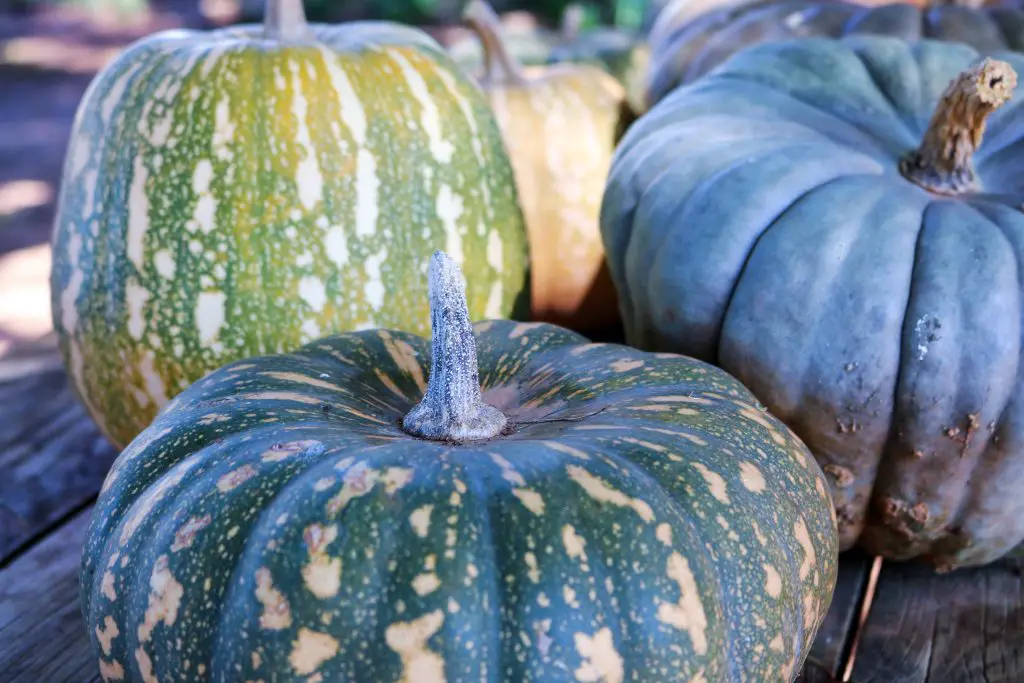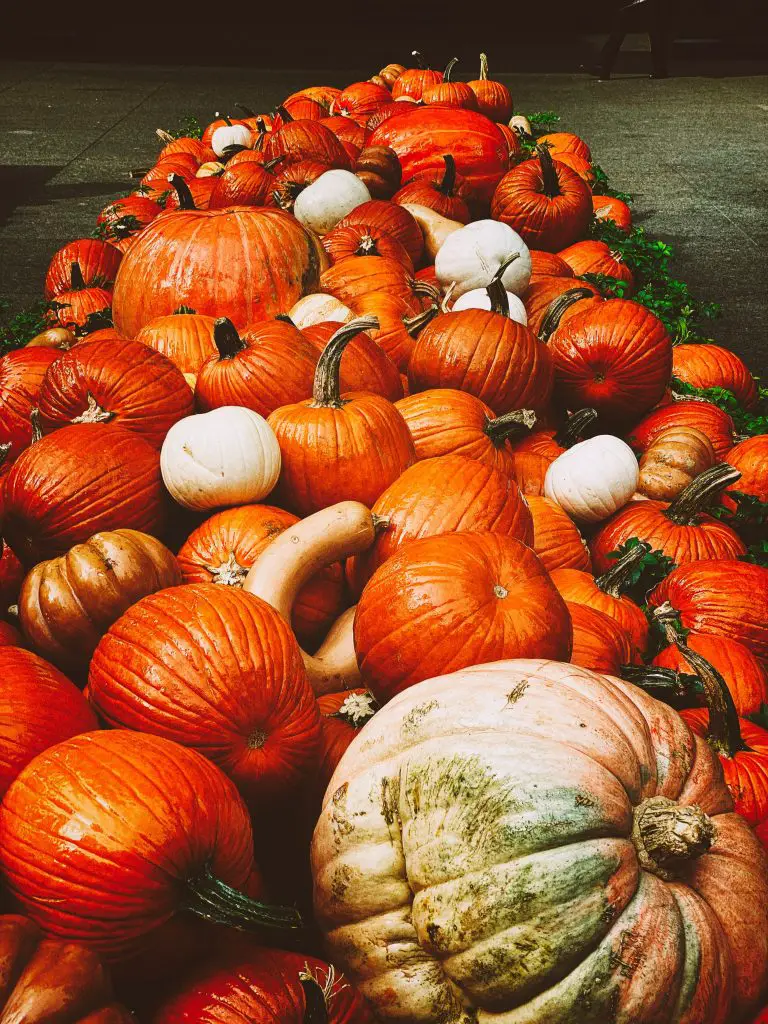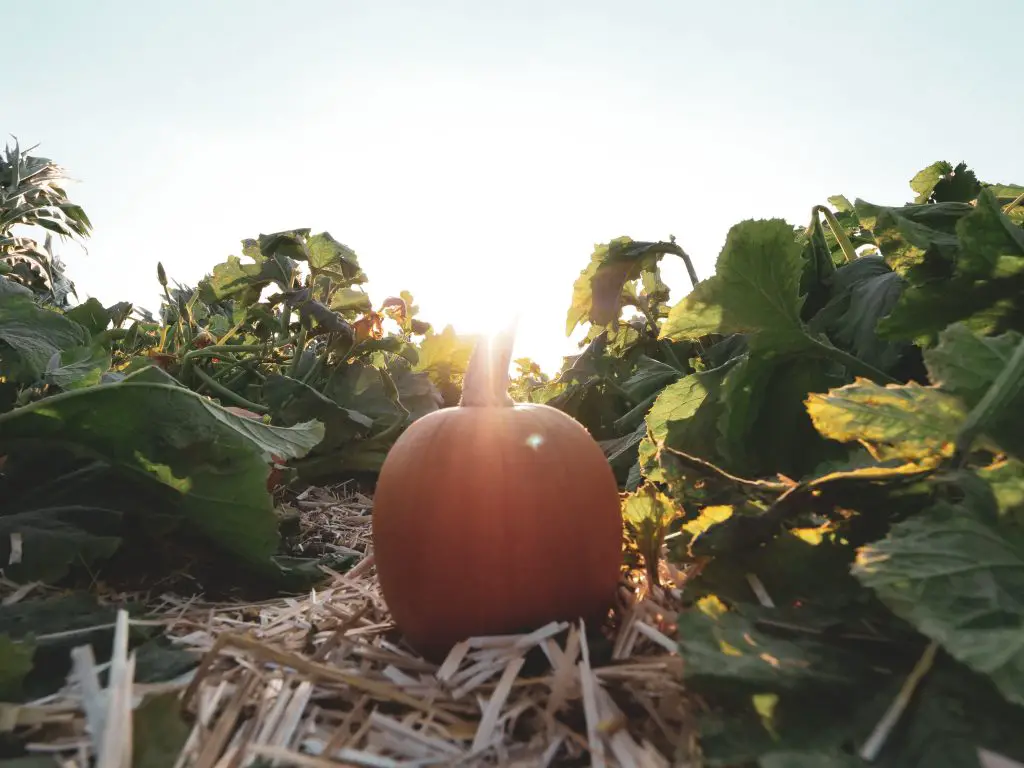Why Are My Pumpkin Leaves Turning White? If you have ever grown in any plants in the cucurbit family such as pumpkins you almost certainly seen the leaves of the plant developing a white powdery residue on the surface of the leaves. In some year it will be so bad that that leaves will turn completely white. Is this normal? Can I do something to prevent it?
The most common reason for the leaves of a Pumpkin to turn white, is powdery mildew. It is a fungus that can cause the leaves to become covered in a white powdery residue. It first appears as white, powdery spots. These spots gradually spread and a pumpkin plant that is severely affected, may have a reduced yield, shorter growth time and produce pumpkins with little flavour. It has been treated using a range of chemicals however, a dilute milk spray, applied once every 2 weeks often is sufficient to eliminate the problem.
Powdery mildew appears late in the growing season and most commonly affects plants from the Cucurbit family. It is generated by fungal spores that overwinter inside leaf buds and other plant debris. In the Spring, when the weather begins to warm up, fungi spores multiply. This results in the spores being dispersed into the air, which allows them to be spread by wind, water and insects, throughout your garden. Once the spores land on a suitable host they will begin to multiply further. The most susceptible plants are Zucchini, Beans, Cucumbers, Squash, Pumpkins and to a lesser degree Tomatoes, Roses and Zinnia.

Will Powdery Mildew Kill My Pumpkins?
Fortunately, powdery mildew is not a fatal disease for Pumpkins or other Curcurbit plants. Besides looking unsightly, its main impact is that it will reduce the amount of photosynthesis occurring within the leaves, by reducing the amount of light reaching the leaves of the plant. This, in turn, reduces the plants’ capacity to produce fruit over time.
How to Prevent Powdery Mildew
There are a number of general preventative measures that can be undertaken within the garden to reduce the chances of powdery mildew appearing, which are as follows;
- Place susceptible plants in a sunny location, if practical, as powdery Mildew prefers a shady position.
- Ensure adequate spacing between plants and prune plants as required, to improve air circulation as humid conditions favour the growth of powdery mildew.
- Remove diseased foliage from the plant and clean up fallen debris on the ground.
In addition to these measures, there are a few preventative treatments that can be applied to the plants to help control powdery mildew. One of the oldest methods is the application of Sulfur to the leaves. Dusting Sulphur, which is a powder, is best applied to the plant when the leaves are dry. It has a long-lasting effect but may need to be re-applied after heavy rain. It works best when applied before the first signs of disease appear.

Other effective prevention measures, is the application of milk or neem oil every one or two weeks. The detail of these treatments is discussed in the section below, as both treatments are preventative and will also kill powdery mildew.
In the event that powdery mildew does occur on your plants, it is important to minimize the spread of the disease by picking up any fallen leaves and disposing of them. It is best to put them in the bin rather than composting them as most home compost heaps do not reach high enough temperature to kill off spores.
It is also worth removing the worst affected leaves that are completely white as this will slow the spread of the disease by increasing the air circulation around the plant and allowing for more direct sunlight to hit the remaining leaves.
How to Treat Powdery Mildew
If the preventative measures fail to keep powdery mildew at bay, there are a number of treatments that can help reduce the impact. One of the traditional methods is using milk which has been shown to be more effective than commercial fungicides. In a study published by Wagner Bettiol in 1999 https://doi.org/10.1016/S0261-2194(99)00046-0 it was stated that:
“High concentrations of milk were more effective than the conventional fungicides tested. This study demonstrated that milk is an effective alternative for the control of powdery mildew in organic agriculture.”
To apply milk, dilute it with water, at a rate of 10 to 1 and apply it on a weekly basis at the first sign of infection, or as a preventative measure. Frequent applications will control and sometimes eliminate the disease. The key advantage of this treatment is that it is readily available, low cost, easy to apply and non-toxic.

Neem oil is another effective treatment that can kill powdery mildew in less than 24 hours. The oil works by disrupting spore production. Neem oil should be applied every one to two weeks. The recommended formula is 3 tablespoons of neem oil to 4 litres (one gallon) of water. To avoid causing sunburn, apply it late in the day.
Powdery mildew may also be treated with a dilute spray, containing Sodium Bicarbonate (Baking Soda). This has generally been found to be not as effective in controlling powdery mildew, despite there being a widespread public view that Sodium Bicarbonate has antiseptic properties, and is suitable for range of applications.
Linda Chalker-Scott of Washington State University stated in a 2017 article, “Miracle, Myth…or Marketing? Baking Soda: Will Fungi Fail and Roses Rejoice?” that public perception is based on research conducted in the 1930’s. Subsequent research later confirmed that Sodium Bicarbonate retards growth, due to the alkaline pH generated, but does not kill the bacteria.

Additionally, persistent use of Bicarbonate Soda has the potential to modify the soil pH overtime, which may become problematic if you have soil that is neutral or slightly alkaline. The ideal pH for most vegetables is approximately 6.5-7.0. To read more about the significance of pH on the growth of vegetables go to https://planyourpatch.com/why-is-ph-important-in-soil/.
Copper Sulfate, commonly known as Bluestone is another traditional remedy, that is one of the two key ingredients used to make Bordeaux mixture. Bordeaux mixture has been used successfully for more than 150 years on fruits, vegetables, and ornamentals in the walled gardens of France and the UK.
Bordeaux mixture, comes in several formulations. One of the most well known formulas is the 4-4-50 formulation. The numbers translate into the number of pounds of copper sulfate (4) and pounds of lime (4) that should be in 50 gallons of water. The drawback of using this is Copper can become toxic, if it is present in sufficient quantities, it also has the potential to cause sunburn if used on bright sunny days.
Related Articles
Can I plant pumpkin seeds from a store brought pumpkin?
How Much Space Do You Need Between Pumpkin Plants?
How Many Pumpkins Are Produced Per Plant? And How Big Are They?
Do Pumpkins Grow Back Every Year?
Can Pumpkin Be Grown In A Pot? (And Here Is How To Do It)
Are Pumpkins Berries? If So, Why?
